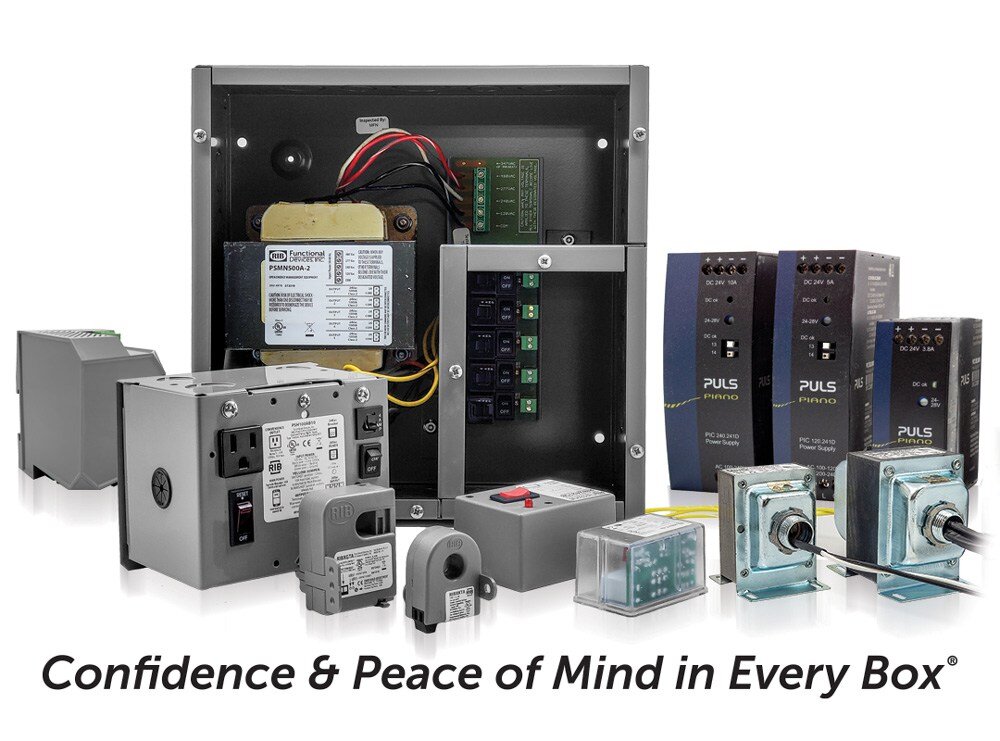
Variable Frequency Drives (VFDs) are the backbone of modern building automation, enabling precise motor speed control, energy savings, and smoother starts. However, monitoring equipment powered by VFDs requires sensors capable of handling fluctuating signals and electrical noise.
RIB® current sensors from Functional Devices provide a simple, accurate way to monitor current draw, equipment status, and performance in VFD-driven systems. Browse our full line and reach out with any questions about your specific automation application.

Let’s explore how RIB current sensors integrate with VFDs, their benefits, and practical tips for installation and operation.
Understanding VFDs
A VFD adjusts the frequency and voltage supplied to an electric motor, allowing variable speed control, reduced energy use, and soft-start capability. Commonly found in HVAC fans, pumps, and industrial systems, VFDs are integral to efficient building operations.
Because VFD outputs fluctuate and produce electrical noise, current sensors designed for stability and accuracy are necessary to track performance and detect potential faults.
Why RIB Current Sensors Are Ideal for VFD Applications
RIB current sensors offer reliable, real-time monitoring of motor current in VFD applications. By converting the monitored current into a stable, low-voltage signal, these sensors allow building automation systems to accurately track load changes, detect equipment issues, and trigger control responses—all while withstanding the harsh electrical environment created by VFDs.
Here are some of their key features:
- True RMS sensing (on select models). Ensures accurate readings even with the non-sinusoidal waveforms produced by VFDs.
Adjustable or fixed thresholds. Lets installers match the sensor to the specific application. - Split-core design. Enables installation without disconnecting existing wiring.
- Noise immunity. Handles EMI and harmonic distortion typical of VFD outputs.
These features are great on paper; however, when using an RIB current sensor for a VFD application, remember these two key points.
Determining Sensor Placement
When using a RIB current sensor to monitor the status of a VFD, the sensor placement is crucial. It should be placed on the line side of (before) the VFD. The ideal frequency of the monitored wire should be at, or around, 60Hz. If it is placed on the load side of (after) the VFD, expect erratic or no operation of the current sensor. This is due to the frequency being altered at the output of the VFD controller.
Using a Model with an Adjustable Threshold
There's a good chance that the VFD consumes some power without the motor turning. That little bit of power is what I call leakage or standby current. It may be enough to make the current sensor contacts close. This could result in a "false-positive" in terms of feedback. By using an adjustable model, the threshold may be fine-tuned to ignore the leakage/standby current, giving you the desired feedback from the current sensor.
Installation Tips
Besides taking the placement of the sensor into consideration, here are some other installation tips to keep in mind:
- Use split-core sensors for retrofit installations. They save time and minimize system downtime.
- Match sensor rating to the motor load. Ensures accurate readings across the entire operating range.
- Keep sensor wiring separated from high-voltage VFD conductors. Minimizes the chance of electrical interference.
- Take advantage of adjustable thresholds. Fine-tune sensitivity to the VFD-driven equipment’s normal current.
If you ever have an installation question, don’t hesitate to reach out.
Updated for 2025
RIB current sensors have evolved to meet the demands of today’s high-efficiency, high-speed VFD systems. Newer models offer:
- Improved True RMS accuracy for distorted waveforms.
- Expanded current ranges to accommodate larger motors.
- Enhanced electromagnetic interference (EMI) shielding to ensure stable signals.
Functional Devices continues to innovate, keeping RIB current sensors at the forefront of building automation and VFD monitoring solutions.
FAQs About RIB Current Sensors and VFDs
Q: Can RIB current sensors handle the distorted waveforms from a VFD?
A: Yes. Select models use True RMS sensing to accurately monitor non-sinusoidal waveforms produced by VFDs.
Q: Are RIB current sensors easy to install in existing panels?
A: Absolutely. The split-core design allows the sensor to clamp around an existing conductor without disconnecting wiring.
Q: Can a current sensor detect belt loss or jammed equipment on a VFD motor?
A: Yes. By monitoring current trends, the sensor can detect both underload and overload conditions tied to mechanical issues.
Q: How do I choose between a fixed or adjustable threshold model?
A: Fixed-threshold models are ideal for consistent loads, while adjustable-threshold models provide flexibility for variable loads or changing conditions.
Q: Do RIB current sensors require special shielding or grounding with VFDs?
A: Good grounding practices and keeping low-voltage sensor wiring away from high-voltage conductors is recommended to minimize interference.
Enhancing Building Automation with Current Sensors
Integrating current sensors into a building automation system provides reliable status feedback from VFD-controlled motors, helping facility teams monitor equipment efficiently. RIB current sensors track when fans, pumps, and other loads are truly active, offering visibility into runtime patterns, verifying control sequences, and supporting energy-saving initiatives.
Using adjustable threshold sensors helps your system distinguish true motor activity from low-level standby currents, reducing false signals and ensuring accurate monitoring. This precise feedback supports better maintenance decisions and smoother operation of mechanical systems.
For more information about RIB current sensors in VFD applications, contact our team. We’re always happy to help.
About Functional Devices, Inc.

Functional Devices, Inc., located in the United States of America, has been designing and manufacturing quality electronic devices since 1969. Our mission is to enhance lives in buildings and beyond. We do so by designing and manufacturing reliable, high-quality products for the building automation industry. Our suite of product offerings include RIB relays, current sensors, power controls, power supplies, transformers, lighting controls, and more.
We test 100% of our products, which leads to less than 1 out of every 16,000 products experiencing a failure in the field.
Simply put, we provide users of our various products confidence and peace of mind in every box.

